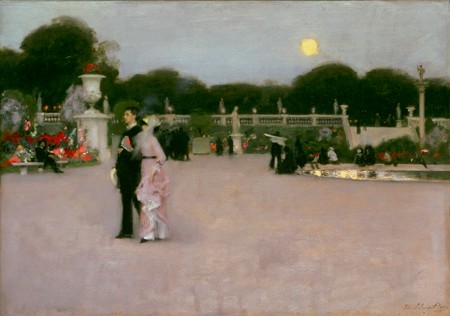“Electric Paris,” the book I have been writing during my time at CASVA, takes root in the often overlooked fact that lighting (éclairage) was a key attribute of nineteenth-century Paris, the City of Light. The French capital had been known as la ville lumière since the eighteenth century because of its prominence during the Enlightenment, but the nickname as metaphor acquired a descriptive valence for the first time in the nineteenth-century glory days of Parisian gaslight, the 1840s and 1850s. It was, however, one of the first cities to experiment with the newest forms of highly technologized outdoor light, electric arc lighting. Arc lamps were installed as streetlights on an experimental basis in prominent sites from 1878 to 1881. The first Exposition Internationale de l’Électricité took place in Paris in 1881, and the era of what I call illumination discourse began.
The culture-wide preoccupation with lighting drives my study of diverse artistic practices and works in which visual culture was entangled with the visualities and hardwares of artificial illumination. Engaging a discussion of éclairage in the domain of the history of later nineteenth-century art provides a counterweight to art history’s century-and-a-half-long romance with natural light. The most conspicuous examples of heliocentric artistic practices were landscape and cityscape photography and the innovative landscape painting of the later 1800s, headquartered in the Paris region, which probingly investigated natural light, especially the flux of sunlight and clouds. My approach to naturalistic art in and around Paris does not seek to reinterpret sunshine based art practices as Luddite but rather repositions daytime plein-air art making as a more deliberate, even quirky choice.
The pitched social, aesthetic, and technical debate about the new forms of artificial illumination took shape along an axis defined by dazzle (blindness) at one end and illumination (visibility) at the other. I maintain that the new lights, their visual properties, and the era’s debates about them provided circumstances that stimulated the conception of aesthetically innovative art gingerly balanced, vis-à-vis the lights themselves, between rejection and embrace, disavowal and enthusiasm.
Thanks to the assistance of research associate Joseph Hammond and the stimulating critical environment of CASVA, I completed a long book introduction as well as several chapters that study the reactions of three visual artists and many caricaturists to aspects of the French capital’s brash new lighting environment. My participation in a National Gallery of Art symposium about the work of Charles Marville (1813–1879) enabled me to consider and to incorporate into the compass of the book a subject I had not previously studied: Marville’s remarkable corpus of streetlamp photos. My interpretation of works by John Singer Sargent (1856–1925), Mary Cassatt (1844–1926), and Edvard Munch (1863–1944) demarcates their use of a language of metaphor, displacement, and/or indirection to acknowledge, deflect, and redefine the controversial visualities of the new lights. Sargent’s two paintings from 1879 of the Jardin du Luxembourg are singular modern urban nocturnes that pastoralize a locus under assault by new lights while also disenchanting a tonalist moonlight.
In one chapter I argue that a moderator lamp prominently featured in a corpus of monochrome intaglio prints that Cassatt set in her own apartment (c. 1880–1882) is a displaced reference to arc streetlamps and the shattering of luminophilia by luminophobia. Another chapter analyzes products of Munch’s stint in France (Paris, Saint-Cloud, Le Havre, and Nice) between 1890 and 1897, when he set no fewer than seventeen works—paintings, pastels, and etchings—in threshold space at night. Their key elements are nighttime settings, people looking intensely through windows, and modern éclairage.
A third chapter discusses material I thought about for the first time at CASVA: the responses of three of the great caricaturists of the era—Cham (Amédée Charles Henri de Noé, 1818–1879), Draner (Jules Jean Georges Renard, 1833 – 1926), and Albert Robida (1848–1926)—to the new illuminations. Thomas Edison’s seemingly boundless ingenuity and the dazzling lights of the era were godsends to the caricaturists and illustrators of Paris. The confusion, excitement, novelty, and visual dazzle of the new lights inspired the invention of novel occasions for sexual mischief and interpersonal deceit in the Parisian theater of everyday life. New subjects drove comic art onto boisterous and profoundly imaginative terrain. That developments in electricity closely coincided with Albert Robida’s founding in 1880 of the magazine La Caricature, an outlet for many of these visual works, was a tremendous boon for Parisian visual culture.
Members' Research Report Archive
Electric Paris: Episodes from the Visual Culture of the City of Light in the Era of Thomas Edison
S. Hollis Clayson, Northwestern University
Samuel H. Kress Professor, 2013–2014

John Singer Sargent, In the Luxembourg Gardens, 1879. Philadelphia Museum of Art, John G. Johnson Collection, 1917
The Inescapability of the Eiffel Tower
S. Hollis Clayson, Northwestern University
Paul Mellon Visiting Senior Fellow, November 1–December 31, 2017